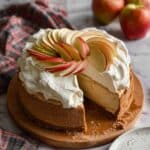Apple Cider Cheesecake Recipe
This Apple Cider Cheesecake is a luscious, creamy dessert perfect for autumn or any special occasion. With a spiced cider reduction incorporated into a smooth cream cheese filling and a crunchy digestive cookie crust, it blends warming mulling spices with the tangy sweetness of sour cream and apple cider. The water bath baking method ensures a silky texture, making each bite a delightful balance of richness and seasonal flavor.
- Prep Time: 30 minutes
- Cook Time: 1 hour 30 minutes
- Total Time: 10 hours (including chilling time)
- Yield: 1 (8-inch) cheesecake, serves approximately 10
- Category: Dessert
- Method: Baking
- Cuisine: American
Ingredients
Crust
- 270g (2 packed cups) digestive cookies or graham crackers
- 85g (6 tablespoons) butter, melted
- ¼ teaspoon salt
- 2 tablespoons powdered sugar
Cider Reduction
- 720g (3 cups) fresh apple cider (honeycrisp cider suggested for tartness)
- Mulling spices (cinnamon sticks, cloves, allspice, star anise – about 2 teaspoons mixed spices)
Cheesecake Filling
- 3 full fat cream cheese bricks (227g each), softened and at room temperature
- 200g (1 cup) brown sugar
- ½ teaspoon salt
- 2 teaspoons pure vanilla extract
- 240g (1 cup) sour cream
- ⅓ cup reduced apple cider syrup (from above)
- 1 teaspoon cinnamon
- 3 large eggs
- 2 tablespoons all purpose flour
Instructions
- Reduce the Cider: In a large pot, bring the fresh apple cider and mulling spices to a boil over high heat. Continue boiling for about 1 hour until it thickens into a syrup and reduces to approximately 1/3 cup. Set aside to cool completely.
- Preheat Oven for Crust: Preheat your oven to 350°F (175°C) to prepare for baking the crust.
- Prepare Crust Base: Using a food processor, pulse the digestive cookies or graham crackers until finely ground. Add melted butter, salt, and powdered sugar; pulse again until the mixture forms wet crumbs that hold together when pressed.
- Form and Bake Crust: Press the crust mixture firmly into the base of an 8-inch round springform pan wrapped with foil or a greased and parchment-lined 8-inch cake pan. Bake for 10 minutes, then allow to cool completely and chill in the refrigerator.
- Lower Oven Temperature: Decrease the oven temperature to 325°F (163°C) for baking the cheesecake filling.
- Beat Cream Cheese and Sugar: In a stand mixer fitted with a paddle attachment, beat the softened cream cheese and brown sugar on medium speed until smooth and free of lumps, scraping down the bowl as needed.
- Add Remaining Filling Ingredients: Incorporate the sour cream, vanilla extract, salt, cinnamon, and cooled reduced apple cider syrup into the cream cheese mixture. Beat until creamy, scraping down the sides intermittently.
- Incorporate Eggs and Flour: Add the eggs one at a time, followed by the flour. Beat on low speed just until combined to avoid overmixing.
- Prepare Water Bath: Place the cheesecake pan inside a larger 13×9-inch baking pan. Pour hot water into the outer pan until it reaches halfway up the sides of the cheesecake pan to ensure gentle and even baking.
- Fill and Bake Cheesecake: Pour the cheesecake filling over the cooled crust. Bake at 325°F for 90 minutes or until the edges are set and the center is slightly wobbly. Avoid opening the oven during baking.
- Initial Cooling in Oven: Turn off the oven and slightly crack open the oven door with a wooden spoon. Let the cheesecake cool inside for about 30 minutes to prevent cracking.
- Further Cooling: Close the oven door and allow the cheesecake to cool for an additional 15 minutes inside.
- Final Cooling and Refrigeration: Remove the cheesecake from the oven and let it cool at room temperature. Once cooled, refrigerate the cheesecake for at least 8 hours or overnight before serving to fully set.
Notes
- Using honeycrisp apple cider provides a nice tartness that complements the sweetness of the cheesecake.
- Ensure the cream cheese is fully softened at room temperature to avoid lumps in the batter.
- Water bath baking is essential to prevent cracks and give the cheesecake a creamy texture.
- Cooling the cheesecake gradually in the oven helps reduce cracking on the surface.
- Chilling the crust before adding the filling improves the crust’s texture and prevents sogginess.
Find it online: http://bitezly.com/apple-cider-cheesecake-recipe/

